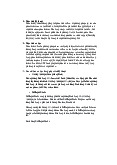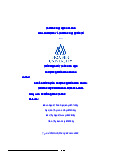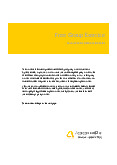














Preview text:
Free Group Exercise Candidate Guidance Booklet Contents
SECTION 1: Example Exercise Discussion Points ........................................................................ 2
SECTION 2: Competencies and Behavioural Indicators ............................................................. 6
SECTION 1: Example Exercise Discussion Points
In this section we present some example discussion points which could come up during this
group exercise. These points are designed to get you thinking about your own responses
and how you might react to other people’s ideas. This section should not be considered a
‘model’ answer as there will be numerous other suggestions and outcomes from the same
group exercise which are equally appropriate. Indeed, group exercises are designed not to
have one right answer, but to promote the discussion of ideas and resolution of differing
viewpoints. You may well come up with other ideas to ours, but much more important than the ideas themselves are you come up with them and how
how you interact with the group to reach agreement.
1.1 Offering online banking services Pros:
- Once live, should be a low-cost service to operate. Action: research what costs and resourced are
involved in running an online banking service. What expertise do they need to bring in?
- Provides future flexibility for S&B; this revenue stream should not be affected if S&B have to close
physical branches as part of future scaling back.
- Online customers may be drawn to other services provided by S&B (e.g. mortgages, financial advice, credit cards, etc.)
- The convenience of online banking may help retain existing customers who were thinking of
leaving for another bank anyway, regardless of whether they are moving out of the north east area.
- May reduce staff workload in the physical branches if customers use online banking instead of cashier banking.
- Global audience; gives access to a much larger market.
- The online platform may help develop new products because customer feedback can quickly be
sought from online surveys, new ideas can quickly be trialled and changes can generally be rolled
out faster online. i.e. this might prove a useful test-bed for future product changes and customer feedback. Cons:
- Unknown technology; will either have a steep learning curve in-house or will have to buy in outside
expertise to implement the online service. Action: research costs of hiring a consultancy service.
Action: look into what outsourced online banking services are available. Also investigate the
possibility of white-labelling someone else’s online service, at least until a firmer idea of customer interest is obtained.
- Current account banking is likely to be a low profit margin business, so how much cross-selling can
be done online? For example online loan applications should be looked into.
- What are the risks and protections against online fraud? Action: research figures for losses through online fraud.
- For relocating customers who want a physical bank branch, online services will not prevent them
changing to a bank which has branches in their new local area. Action: conduct customer survey to
establish how many customers this might case might apply to.
- Will need to investigate regulation of online banking, for example do account holders need to
come into the bank in person as part of fraud prevention regulations? This would negate a lot of the
You may share this document with others as long Page
as you credit AssessmentDay.co.uk with a website
link but you can’t change this document in any www.assessmentday.co.uk
way or use its contents commercially.
Document last updated 05-07-2013
benefits to the online proposition. Action: research applicable legislation surrounding provision of online banking services.
- New service will work best if there is no resistance from board members. There should be no
internal politics or agendas at board level.
- Promotion of new online service will be difficult beyond existing customers; the competition for
online banking is fierce and online advertising in this area is expensive. Action: research the
acquisition costs of new online customers and the potential new income they will bring, with a view
to produce a cost-benefit analysis.
1.2 Attracting customers from a non-trading competitor
- Speak to the failed competitor IB business managers to find out any inside information on what
customers wanted. These people will have very useful information about the existing customers.
Thought will need to be given to the incentivisation of these ex-mangers; why should they help S&B?
- S&B could buy client contact information from the non-trading competitor or administrator. This
would have to be done sensitively to not infringe data protection and not to offend potential clients.
- Speak to customers and ask them what they liked about previous provider.
- Find out what their concerns are and address them.
- Find out why the previous company failed – should this be a warning to not enter the market?
- Consider what competitors will be offering to these clients. Can S&B match or better their offering?
- Convey to potential customers the virtues of local knowledge. Issue prospectuses on recent deals
S&B has advised on, or prospectuses on promising local businesses which would present an
investment opportunity. Include testimonials from happy clients if possible. This will demonstrate
that S&B has contacts and experience in the local area.
- Could advertise in trade journals and business conferences.
- Draw attention to some of the high-profile failures experienced with some international finance
projects, and position S&B as a more responsible, grounded investment bank.
- Start local advertising campaign for publicity. Run adverts in local papers and television adverts.
Sponsor local business events. Perhaps even host an investment competition to generate publicity.
- Speak to existing S&B investment banking clients to see if any of their contacts were
clients of the failed company. A personal recommendation could be very powerful. Maybe
even offer some incentive for referred custom.
- Research will need to be done on what sort of terms the old competitor was offering, in
order to align with customer expectations. For example, what percentage fee did they take,
how did their pricing work, etc.
You may share this document with others as long Page
as you credit AssessmentDay.co.uk with a website
link but you can’t change this document in any www.assessmentday.co.uk
way or use its contents commercially.
Document last updated 05-07-2013
1.3 Islamic banking services First issue
- One idea could be to be to offer the Sharia law-compliant services under a separate sister
company, thus disguising any obvious link between the two. Traditionalist customers whose
perception of the bank might be affected will not easily notice the link, while the expertise and scale
gained from being associated with S&B can be called upon. Action: research what the sister
company could look like, what would appeal to the target customer base, and where branches could
be opened, if they are to be separate from S&B. Second issue
- Again the idea of a separate sister company could alleviate some of the concerns surrounding a
change of culture within S&B. This new separate company will have no precedent to clash with.
- The staff for the new sister company (or new division of S&B) could be a mix of new recruits and
staff who have shown an interest in being involved. By selecting staff who have responded positively
to a in internal survey, the new division may have increased morale and a sense of responsibility to
the success of the new venture. Action: send out a staff survey to see who would be interested in
working in this new department.
- Regarding the cost of external consultants, one idea could be to peg their pay to performance of
the new division, with minimal fee being paid on poor performance. This would reduce some of the
risk of failure, but would probably result in higher fees upon successful implementation. Action:
firm-up cost estimates of hiring an external consultant.
- An expert will need to advise on Sharia compliance and endorse the new products’ compliance. Third issue
- It would be prudent to investigate further on the number of potential customers as we don’t know
the provenance of this survey, its date, or its assumptions. Action: The first thing to do is to check
how reliable this survey is, and depending on the outcome, possible commission a more reliable survey.
- How many competitors are offering Sharia law compliant financial services? If there are no other
local competitors, capturing the whole of this market, even if relatively small, might still be a strong revenue stream.
- Starting off small with this new service may not be such a bad thing, as this could form the first
step of a roll-out strategy stretching to other parts of the county. Action: It is recommended to
research who else is providing these services around the country and consider what their next steps
might be; are they threatening to enter the north east region? Will they provide a credible threat to
S&B expanding the service elsewhere?
- Access to the target customer base will need to be considered: how does this new demographic
bank, where are they likely to see adverts and how are they likely to be persuaded to use the
service? Action: research the target customer demographic and their banking behaviours.
- In tandem with estimating the size of the market, expected revenues and profit margins need to be
estimated to help decide how much resource the bank should invest in this new venture.
You may share this document with others as long Page
as you credit AssessmentDay.co.uk with a website
link but you can’t change this document in any www.assessmentday.co.uk
way or use its contents commercially.
Document last updated 05-07-2013
1.4 Merging with BSP Discussion points
- Need to quantify the size of the toxic debt pile BSP is exposed to. This needs to be offset against
other BSP assists (both tangible and non-tangible) to decide if they are worth merging with. For
example what value is in the BSP business, such as: client list; good performing loans; repeat and
legacy clients; property; new markets; brand, etc? For worst case scenario of all the toxic debts not
being repaid, what is the net value of BSP? This will decide how much (if anything) S&B should pay for it on a worst-case basis.
- Need to identify the reasons for why BSP’s performance has dropped, and particularly if being tied
to the larger S&B will alleviate those problems. What is holding it back? For example, does it need
an injection of capital to fund a recruitment drive, marketing, or a technology upgrade? If it is not a
lack of investment capital, how can S&B help?
- If the risk of losses is too great, perhaps a deal could be forged whereby some of BSP’s attractive
assets are sold to S&B, leaving the poor performing loans behind. This would result in a higher sale
price, but obviously less risk. Success factors
- An honest and frank conversation with the managers at BSP would be sensible to understand what
really needs to be known about the underlying business. Given the previous relationship with S&B,
this is more likely to yield honest answers. Things might get uncovered which formal due diligence
perhaps wouldn’t otherwise uncover.
- Will cost savings and synergy be afforded by joining forces with S&B? Identify where business
operations would be doubled-up and thus where cost savings can be found (e.g. admin, HR,
compliance, market analysis etc.)
- The culture of both organisations, apparently similar, is helpful for success. This would also help if
staff need to be switched between the two organisations.
- The new market areas accessed through the merger would certainly be a quick way to expand
S&B’s reach. Initially this reach would be in only private equity, but it would be a spring-bard to
offer S&B’s other products. We are told that S&B’s services include investment, merchant, retail and
private banking, so of these the private banking would certainly benefit, with some of the others having a new potential reach. Failure factors
- The dropped profitability of BSP could be a warning sign for something wrong with the underlying
business, or even the market of private equity. Why should the profits suddenly improve from ownership by S&B?
- The size of the toxic debt held by BSP should be clarified, even if it’s just an estimate.
- The nature of the toxic debt should be investigated further. What assets can be recovered if the
borrower defaults on the loan? What where the conditions on which the loan was made? I.e. how
much of these loans would have to be written off and how much could be recovered.
- What would be the repercussions of the merged aspects of the business failing? What bridges
would be burnt? If for example some clients or business have to be let down or have to have terms
renegotiated, this would probably have a negative effect on S&B’s overall image. Bad press would cost the firm’s reputation. Decision
- The decision reached by the group is not important for this exercise as long as the decision is
backed up and explained. Expect to be quizzed by the assessor on why the group voted the way it
did. You might have to defend the group’s decision.
You may share this document with others as long Page
as you credit AssessmentDay.co.uk with a website
link but you can’t change this document in any www.assessmentday.co.uk
way or use its contents commercially.
Document last updated 05-07-2013
SECTION 2: Competencies and Behavioural Indicators
This section identifies the key competencies an assessor will typically measure during this
group exercise, and a list of behavioural indicators highlighting that competency. The
competency framework in this exercise is designed to be typical of a real group exercise.
The first list describes positive indicators of that competency, showing behaviours which
indicate a high level of competence. The second list describes negative indicators of that
competency, showing behaviours which actively demonstrate a lack of that competence.
The following competencies are assessed in this exercise are: Leadership Initiative Team working Decisiveness Problem solving Organisational ability
You may share this document with others as long Page
as you credit AssessmentDay.co.uk with a website
link but you can’t change this document in any www.assessmentday.co.uk
way or use its contents commercially.
Document last updated 05-07-2013 Competency: Leadership POSITIVE INDICATORS
Provides support and encouragement to team members
For example you could encourage team members by saying “good idea” and “yes, I like that
idea” when they generate good ideas.
Helps to address the structure of the meeting
For example you could suggest an agenda and time estimates for each issue during the meeting.
Employs different management styles depending on the context
For example you could use a more directive style of management when you need to take
control, and a more diplomatic style of leadership when you need to use a more soft approach.
Takes control and provides focus to the group when required
For example you could ensure that the group does not get side-tracked or distracted.
Gives everyone in the group time to speak and listens to everyone’s input
For example you could go around the group and ask for everyone’s insight in the team. Leads by example
For example you could generate ideas and contribute to the group rather than leaving the work to other members.
Manages conflict and handles disputes within the team
For example you could mediate between disagreements and act diplomatically to prevent
conflicts getting out of hand.
Encourages the input of others
For example you could ensure that quieter members of the team are given opportunity to provide insight.
Ensures that everyone has a sense of unity and encourages team spirit
For example you could build morale by encouraging an open and honest atmosphere.
You may share this document with others as long Page
as you credit AssessmentDay.co.uk with a website
link but you can’t change this document in any www.assessmentday.co.uk
way or use its contents commercially.
Document last updated 05-07-2013 Competency: Leadership NEGATIVE INDICATORS
Takes a strictly autocratic style of leadership
For example you could have given rude or insensitive orders to team members rather than polite requests.
Fails to maintain control of the group
For example you could have let the team become side-tracked and distracted from the brief.
Avoids listening to other team members and leaves them out of the decision making process
For example you could have ignored the input of particular team member and not taken their
contributions into account when coming to conclusions.
Allows conflicts and disputes to occur within the group
For example you could have ignored the fact that two team members were arguing and not provide mediation.
Undertakes a passive role and allows other to overshadow them during the discussion
For example you could have been overly quiet and reserved, allowing other team members
to make decisions which you consider to be ineffective. Competency: Initiative POSITIVE INDICATORS
Raises practical solutions which satisfy multiple constraints
For example you could identify a compromise solution for increasing the likeliness of success
in the merger between S&B and BSP. This might be a solution which isn’t a complete merger but a hybrid solution.
Searches for mutually-beneficial outcomes to problems
For example you could suggest solutions which benefit both S&B and their competitors
where they might otherwise be incompatible. Or try to think of solutions which
simultaneously take into account the proposals put forward by different members in the group exercise.
You may share this document with others as long Page
as you credit AssessmentDay.co.uk with a website
link but you can’t change this document in any www.assessmentday.co.uk
way or use its contents commercially.
Document last updated 05-07-2013
Generates innovative and original solutions to issues
For example you could try to introduce new ideas or approaches which have not been
mentioned. Creative ideas which show you have thought outside of the box may get credited
here even if they are not necessarily practicable. The exercises instructions are there to be
followed, but where there is opportunity to think laterally, try to question any assumptions inherent in the exercise.
Is able to steer the direction of the meeting, helping the group address different issues
For example you could ensure that all the necessary topics are discussed and solutions are
systematically provided. This might include recognising when someone is about to go off on
a tangent to the problem in hand, and bringing them back to the most important issues.
Improves upon the ideas generated by the team
For example you could recognise a good idea and say “that’s a good idea, and I think it could
be improved further by dong this…”
Raises practical solutions which satisfy multiple constraints Competency: Initiative NEGATIVE INDICATORS
Does not contribute towards the content or direction of the discussion
For example you could have remained silent or have been obstructive during the exercise.
Does not explore issues within the discussion through questions
For example you could have avoided going into depth with other team members or could
have accepted an opposing view without seeking justification.
Needed to be prompted by other team members in order to offer suggestions
For example you could have only spoken when spoken to and only provided input when put under pressure.
You may share this document with others as long Page
as you credit AssessmentDay.co.uk with a website
link but you can’t change this document in any www.assessmentday.co.uk
way or use its contents commercially.
Document last updated 05-07-2013 Competency: Team working POSITIVE INDICATORS
Shows a greater concern for the group rather than for self interest
For example you could focus on working as a team rather than trying to compete with other
team members (this is certainly true for group exercises where participants are not assigned
roles; sometimes you will be asked to negotiate the best outcome for your character). You
should be open to changing your mind on an issue if the team present a solution which
appears to satisfy the brief and has been argued strongly.
Offers knowledge and expertise to the benefit of the group
For example you could provide ideas and unique insight that you may have gained through
your personal experience. Some group exercises deliberately give different pieces of
information to different participants so that each person has something which needs to be communicated.
Encourages team members to build upon their ideas
For example you could recognise when a team member has generated a good idea and
discuss with them how to expand upon it.
Listens to the points of others and gives constructive feedback when appropriate
For example you could pay close attention to points raised by others and politely help refine
those points using your own knowledge and expertise. If an idea put forward doesn’t satisfy
an aspect of the brief, you should point this out without being dismissive or critical.
Provides regular contributions towards group discussion
For example you could ensure that you bring up different points throughout the discussion
rather than repeating the same points made by others.
Actively tries to improve and maintain morale and enthusiasm within the group.
For example you could try and encourage a more open and collaborative environment and
avoid letting the group feel tense and uneasy. Sometimes the atmosphere can get tense and
if you add a light-hearted comment with a smile this helps to keep the group as a collaborative team.
Provides support for decisions made by the group when voting
For example you could avoid being overly challenging and staunchly disagreeing when the
rest of the team has made a decision.
Is flexible and does not oppose group decisions at the expense of the rest of the team
For example you could avoid spending too long voicing disagreements at the expense of covering other issues.
You may share this document with others as long Page
as you credit AssessmentDay.co.uk with a website
link but you can’t change this document in any www.assessmentday.co.uk
way or use its contents commercially.
Document last updated 05-07-2013



